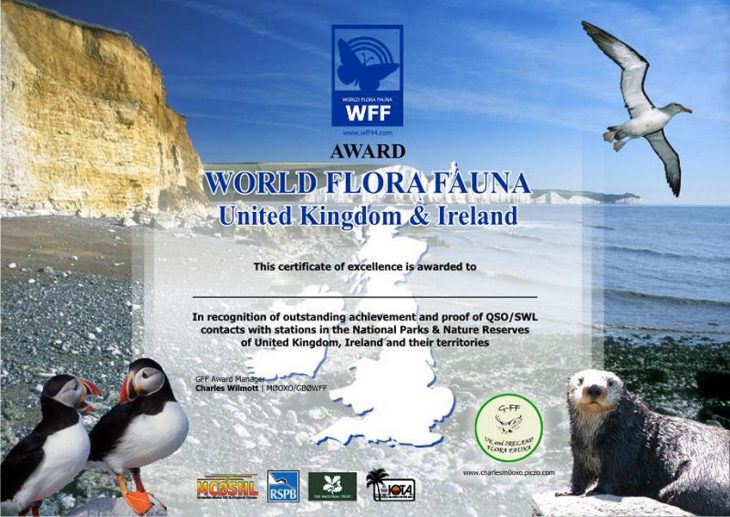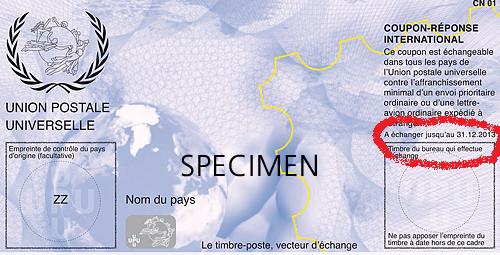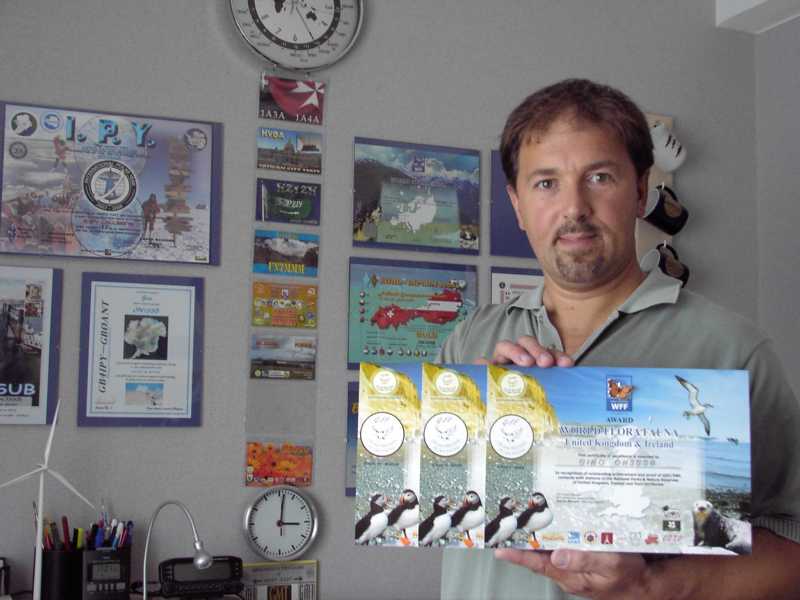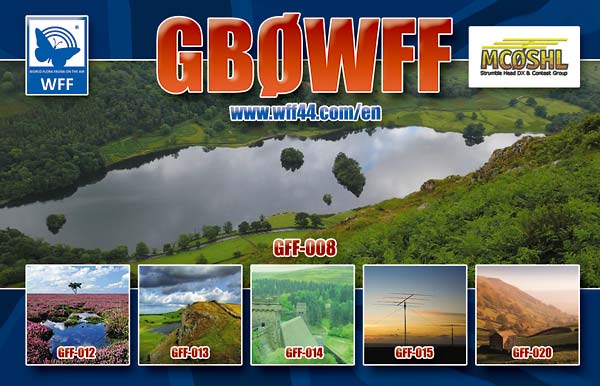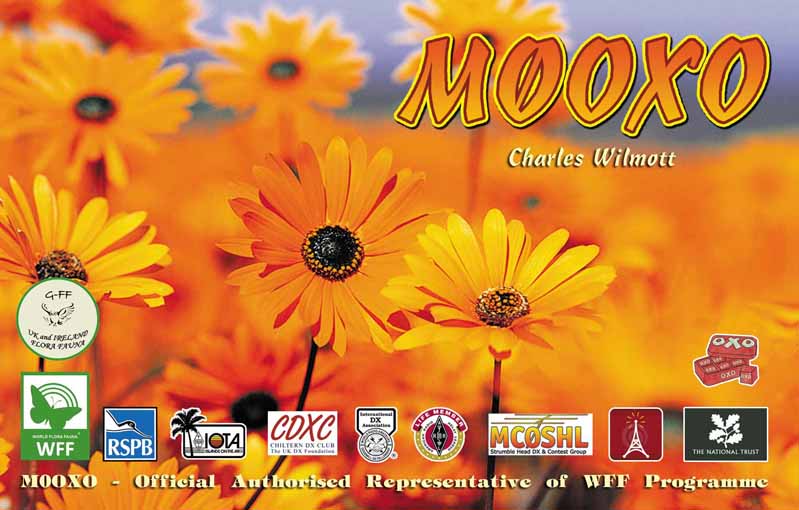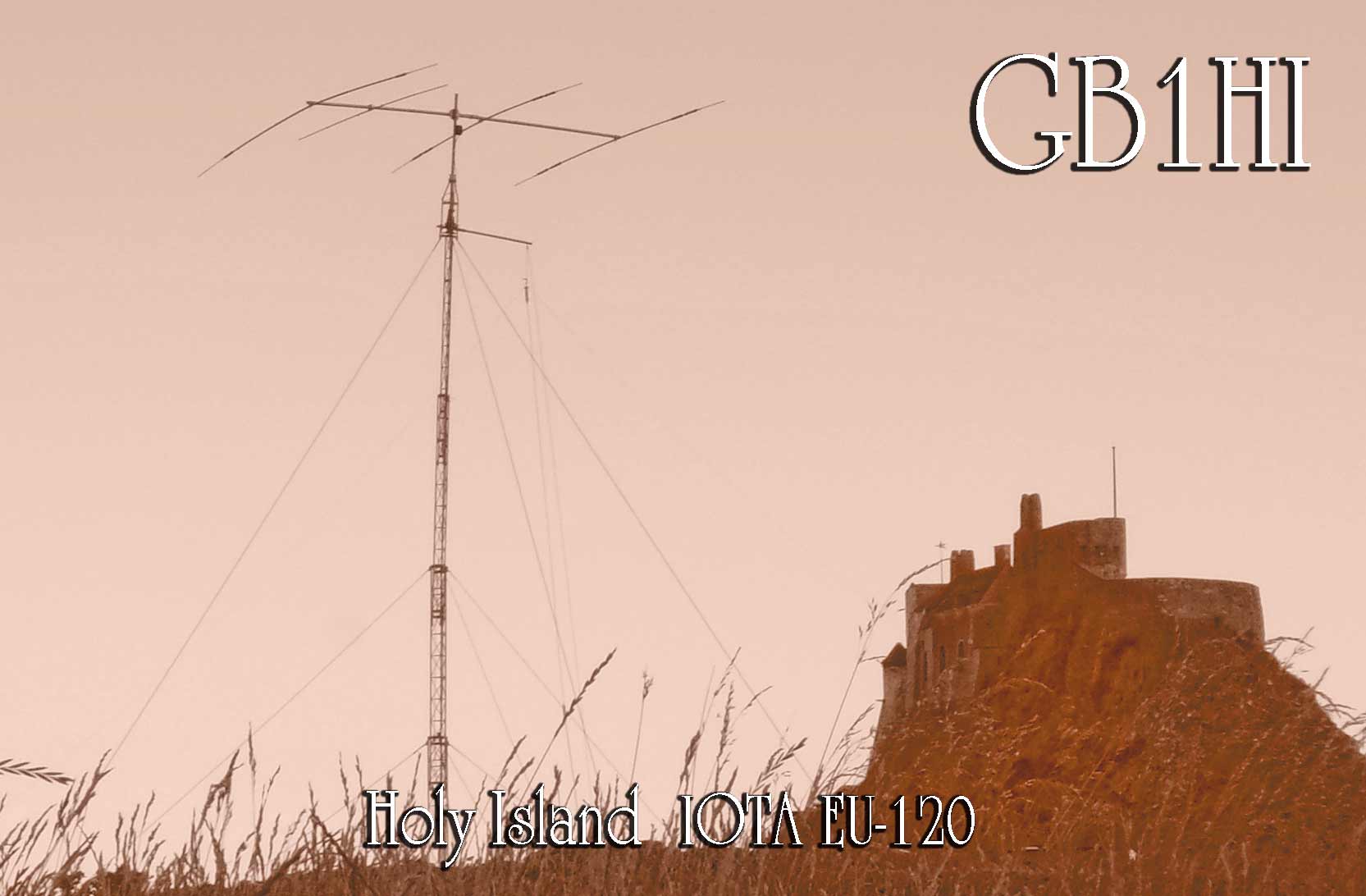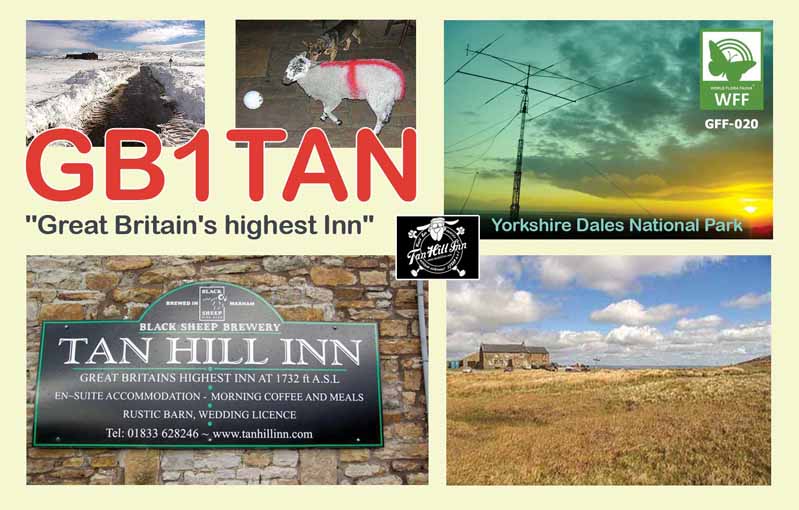Below is the list for ‘GFF’ up to and including :- 07/09/2011
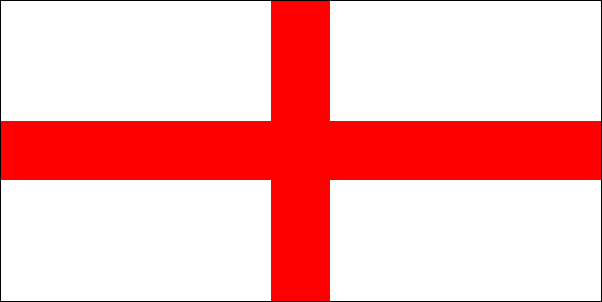
**Areas shown in BLUE are ‘most recent activation by’
**Areas NOT shown in BLUE are ‘not yet activated’
| England | GFF-001 | New one | Brecon Beacons *now GWFF-073 |
| England | GFF-002 | New one | |
| England | GFF-003 | Chalk Sound | |
| England | GFF-004 | Dartmoor | |
| England | GFF-005 | East Bay Islands | |
| England | GFF-006 | Exmoor | |
| England | GFF-007 | Grand Turk Cays, Land and Sea | |
| England | GFF-008 | Lake District | (G4OBK) (M6ONL) |
| England | GFF-009 | New one | |
| England | GFF-010 | New Forest | (M6ADB) |
| England | GFF-011 | North West Point Marine | |
| England | GFF-012 | North York Moors | (G4OBK) ((M6ADB) |
| England | GFF-013 | Northumberland | (GB1TAN/M0OXO) |
| England | GFF-014 | Peak District | (M0OXO) (G1INK) (G4OBK) |
| England | GFF-015 | Pembrokeshire Coast | (GB0WFF/M0OXO) (MC0SHL) |
| England | GFF-016 | Princess Alexandra Land and Sea | |
| England | GFF-017 | New one | Snowdonia *Now GWFF-074 |
| England | GFF-018 | South Downs | (M6ADB/p several times) |
| England | GFF-019 | The Broads | (G7SQW) |
| England | GFF-020 | Yorkshire Dales | (GB1TAN)(G1LAT) (G1INK) |
| England (Ant. Base) | GFF-021 | Ferguson Bay Base Camp | |
| England (Ant. Base) | GFF-022 | Station “Bl” Bird Island Station | |
| England (Ant. Base) | GFF-023 | Station “M” King Edward Point | |
| England (Ant. Base) | GFF-024 | Falkland Islands | |
| England (Ant. Base) | GFF-025 | Husvik, South Georgia isl. | |
| England (Ant. Base) | GFF-026 | Spenceley Glacier Camp | |
| England (Ant. Base) | GFF-027 | Grytviken, , South Georgia isl. | |
| England (Ant. Base) | GFF-028 | SANAP Weather Station | |
| England (Ant. Base) | GFF-029 | Base «W» Detaille Island | |
| England (Ant. Base) | GFF-030 | Brabant Station | |
| England (Ant. Base) | GFF-031 | Smith Base | |
| England (Ant. Base) | GFF-032 | Station «A» Port Lockroy | |
| England (Ant. Base) | GFF-033 | Station «B» Deception Island | |
| England (Ant. Base) | GFF-034 | Station «C» Cape Geddes | |
| England (Ant. Base) | GFF-035 | Station «D» Hope Bay | |
| England (Ant. Base) | GFF-036 | Station «E» Stonington Island | |
| England (Ant. Base) | GFF-037 | Station “F” Faraday (James Wordie House) | |
| England (Ant. Base) | GFF-038 | Station «F» Faraday Station | |
| England (Ant. Base) | GFF-039 | Station «G» Admiralty Bay | |
| England (Ant. Base) | GFF-040 | Station «H» Signy Island | |
| England (Ant. Base) | GFF-041 | Station «KG» Fossil Bluff | |
| England (Ant. Base) | GFF-042 | Station «O» Danco Island | |
| England (Ant. Base) | GFF-043 | Station «R» Rothera | |
| England (Ant. Base) | GFF-044 | Station «T» Adelaide | |
| England (Ant. Base) | GFF-045 | Station «Y» Horseshoe Island | |
| England (Ant. Base) | GFF-046 | Station “Z” Edmond Halley I | |
| England (Ant. Base) | GFF-047 | Station “Z” Edmond Halley II | |
| England (Ant. Base) | GFF-048 | Station “Z” Edmond Halley III | |
| England (Ant. Base) | GFF-049 | Station “Z” Edmond Halley IV | |
| England (Ant. Base) | GFF-050 | Station “Z” Edmond Halley V | |
| England (Ant. Base) | GFF-051 | Western Bransfield Strait | |
| England (Ant. Base) | GFF-052 | Western Shore of Admiralty Bay | |
| England | GFF-053 | Pitcairn island (include Oeno) | |
| England | GFF-054 | Henderson island | |
| England | GFF-055 | Ducie island | |
| England | GFF-056 | Gordano Valley | Avon (G4WSB) |
| England | GFF-057 | Barton Hills | Bedfordshire |
| England | GFF-058 | Chiltern Hills | Bedfordshire (M6ADB) |
| England | GFF-059 | Kings Wood, Heath & Reach | Bedfordshire |
| England | GFF-060 | Knocking Hoe | Bedfordshire |
| England | GFF-061 | The Lodge | Bedfordshire |
| England | GFF-062 | Leigh Woods | Bristol (G4WSB) |
| England | GFF-063 | Church Wood | Buckinghamshire |
| England | GFF-064 | Barnack Hills & Hoes | Cambridgeshire |
| England | GFF-065 | Bedford Purlieus | Cambridgeshire |
| England | GFF-066 | Castor Hanglands | Cambridgeshire |
| England | GFF-067 | Chippenham Fen | Cambridgeshire |
| England | GFF-068 | Fowlemere | Cambridgeshire (M6ONL) |
| England | GFF-069 | Holme Fen | Cambridgeshire |
| England | GFF-070 | Monks Woods | Cambridgeshire |
| England | GFF-071 | Nene Washes | Cambridgeshire (M6ONL) |
| England | GFF-072 | Ouse Washes | Cambridgeshire (M6ONL) |
| England | GFF-073 | Upwood Meadows | Cambridgeshire |
| England | GFF-074 | Wicken Fen | Cambridgeshire (M6ADB/p) (M6ONL) |
| England | GFF-075 | Woddwalton Fen | Cambridgeshire |
| England | GFF-076 | Gayton Sands | Cheshire |
| England | GFF-077 | Wybunbury Moss | Cheshire |
| England | GFF-078 | Golitha Falls | Cornwall |
| England | GFF-079 | Goss Moor | Cornwall |
| England | GFF-080 | The Lizard | Cornwall |
| England | GFF-081 | Hayle Estuary | Cornwall |
| England | GFF-082 | Marazion Marsh | Cornwall |
| England | GFF-083 | Campfield marsh | Cumbria |
| England | GFF-084 | Finglandrigg Woods | Cumbria |
| England | GFF-085 | Haweswater | Cumbria (M6ONL) |
| England | GFF-086 | Hodbarrow | Cumbria |
| England | GFF-087 | Hutton Roof Crags | Cumbria (G4WSB) (G1LAT) |
| England | GFF-088 | Moor House | Upper Teesdale (Cumbria) |
| England | GFF-089 | St Bees Head | Cumbria |
| England | GFF-090 | Biggin Dale | Derbyshire |
| England | GFF-091 | Derbyshire Dales | Derbyshire (GB0WFF/M0OXO) |
| England | GFF-092 | Aylesbeare Common | Devon |
| England | GFF-093 | Chapel Wood | Devon |
| England | GFF-094 | Dawlish Warren | Devon |
| England | GFF-095 | East Dartmoor Woods & Heaths | Devon |
| England | GFF-096 | Exe Estuary | Devon |
| England | GFF-097 | Slapton Ley | Devon |
| England | GFF-098 | Arne | Dorset (G4WSB) |
| England | GFF-099 | Ballard Down | Dorset (G4WSB) |
| England | GFF-100 | Garston Wood | Dorset (M6ADB) |
| England | GFF-101 | Holt Heath | Dorset (G4WSB) |
| England | GFF-102 | Lodmoor | Dorset (G1OCN) |
| England | GFF-103 | Lundy Island | Dorset |
| England | GFF-104 | Radipole lake | Dorset (G1OCN) |
| England | GFF-105 | Studland & Godlingston Heath | Dorset (G4WSB) |
| England | GFF-106 | Castle Eden Dene | Durham |
| England | GFF-107 | Durham Coast | Durham |
| England | GFF-108 | Bempton Cliffs | East Riding Yorkshire |
| England | GFF-109 | Blacktoft Sands | East Riding Yorkshire |
| England | GFF-110 | Lower Derwent Valley | East Riding Yorkshire |
| England | GFF-111 | Spurn Point | East Riding Yorkshire (M0OXO) |
| England | GFF-112 | Fore Wood | East Sussex |
| England | GFF-113 | Stour Estuary | Essex |
| England | GFF-114 | Highnam Woods | Gloucestershire |
| England | GFF-115 | Nagshead | Gloucestershire |
| England | GFF-116 | Rainham Marshes | Greater London |
| England | GFF-117 | Ashford Hangers | Hampshire (M6ADB/p) |
| England | GFF-118 | Ashford Hill | Hampshire (M6ADB) |
| England | GFF-119 | Beacon Hill | Hampshire (M6ADB) |
| England | GFF-120 | Butser Hill | Hampshire (M6ADB/p) |
| England | GFF-121 | Castle Bottom | Hampshire (M6ADB/p) |
| England | GFF-122 | Kingston Great Common | Hampshire (M6ADB) |
| England | GFF-123 | Langstone Harbour | Hampshire (M6ADB) |
| England | GFF-124 | Martin Down | Hampshire (M6ADB) |
| England | GFF-125 | North Solent | Hampshire |
| England | GFF-126 | Old Winchester Hill | Hampshire (M6ADB) |
| England | GFF-127 | Tichhfield Haven | Hampshire (M6ADB) |
| England | GFF-128 | Rye Meads | Hertfordshire (M6ADB) |
| England | GFF-129 | Brading Marshes | Isle of White |
| England | GFF-130 | Barnsfield Pit | Kent (M6ONL) |
| England | GFF-131 | Blean Woods | Kent (M6ONL) |
| England | GFF-132 | Cliffe Pools | Kent |
| England | GFF-133 | Dungeness | Kent (M6ONL) |
| England | GFF-134 | Elmley Marshes | Kent |
| England | GFF-135 | Hamstreet Woods | Kent |
| England | GFF-136 | Lydden & Tempell Ewell Downs | Kent (M60NL) |
| England | GFF-137 | Nor Marsh & Motney Hill | Kent |
| England | GFF-138 | Northward Hill | Kent |
| England | GFF-139 | Stodmarsh | Kent |
| England | GFF-140 | Tudeley Woods | Kent (M6ONL) |
| England | GFF-141 | Wye Downs | Kent |
| England | GFF-142 | Gait Barrows | Lancashire (G1LAT/p) |
| England | GFF-143 | Leighton Moss | Lancashire |
| England | GFF-144 | Morecambe bay | Lancashire (G1LAT/P) |
| England | GFF-145 | Ribble Estaury | Lancashire |
| England | GFF-146 | Frampton Marsh | Lincolnshire |
| England | GFF-147 | Freiston Shore | Lincolnshire |
| England | GFF-148 | Gibralter Point (The Wash) | Lincolnshire |
| England | GFF-149 | Saltfleetby-Theddlethorpe Dunes | Lincolnshire |
| England | GFF-150 | Marshside | Merseyside |
| England | GFF-151 | Ainsdale Sand Dunes | Merseyside |
| England | GFF-152 | Ant Broads & Marshes | Norfolk (G7SQW) |
| England | GFF-153 | Brettenham Heath | Norfolk (G1UGH) |
| England | GFF-154 | Blakeney Point | Norfolk |
| England | GFF-155 | Bure Marshes | Norfolk (G7SQW) |
| England | GFF-156 | Berney Marshes & Breydon Water | Norfolk |
| England | GFF-157 | Calthorpe Broad | Norfolk |
| England | GFF-158 | Dersingham Bog | Norfolk (G7SQW) |
| England | GFF-159 | Foxley Wood | Norfolk (G7SQW) |
| England | GFF-160 | Great Yarmoth Little terns | Norfolk |
| England | GFF-161 | Holkham | Norfolk (G7SQW) |
| England | GFF-162 | Redgrave & Lopham Fen | Norfolk (G7SQW) |
| England | GFF-163 | Roydon Common | Norfolk (G7SQW) |
| England | GFF-164 | Scolt Head Island | Norfolk |
| England | GFF-165 | Snettisham | Norfolk (G7SQW) |
| England | GFF-166 | Strumpshaw Fen | Norfolk (G7SQW) |
| England | GFF-167 | Swanton Novers | Norfolk |
| England | GFF-168 | Tichwell Marsh | Norfolk (G7SQW) |
| England | GFF-169 | Weeting Heath | Norfolk (G7SQW) |
| England | GFF-170 | Winterton Dunes | Norfolk (G7SQW) |
| England | GFF-171 | Farne Islands | Northumberland (GX4NOK/M0OXO) |
| England | GFF-172 | Lindisfarne (Holy Island) | Northumberland (GB1HI/GB0HI) |
| England | GFF-173 | Duncombe Park | North Yorkshire |
| England | GFF-174 | Ingleborough | North Yorkshire (G4OBK) (G1LAT) |
| England | GFF-175 | Aston Rowant | Oxfordshire (M6ADB) |
| England | GFF-176 | Otmoor | Oxfordshire (M6ADB) |
| England | GFF-177 | Aqualate Mere | Shropshire |
| England | GFF-178 | Fens, Whixall & Bettisfield Mosses | Shropshire |
| England | GFF-179 | Stiperstones | Shropshire |
| England | GFF-180 | Wyre Forest | Shropshire |
| England | GFF-181 | Brigwater Bay | Somerset (G4WSB) |
| England | GFF-182 | Dunkery & Horner Woods | Somerset |
| England | GFF-183 | Ebbor Gorge | Somerset |
| England | GFF-184 | Grelake | Somerset |
| England | GFF-185 | Ham Wall | Somerset (G3TJE/p) |
| England | GFF-186 | Hardington Moor | Somerset |
| England | GFF-187 | Huntspill River | Somerset (G4WSB) |
| England | GFF-188 | Rodney Stoke | Somerset (G3TJE/p) |
| England | GFF-189 | Shapwick Heath | Somerset (G4WSB) |
| England | GFF-190 | Somerset levels | Somerset |
| England | GFF-191 | Westhay Moor | Somerset (G4WSB) |
| England | GFF-192 | West Sedgemoor | Somerset |
| England | GFF-193 | Old Moor Dearne Valley | South Yorkshire (M0OXO) |
| England | GFF-194 | Coombes & Churnet | Staffordshire |
| England | GFF-195 | Benacre broad | Suffolk (G7SQW) |
| England | GFF-196 | Bradfield Woods | Suffolk (G1UGH) |
| England | GFF-197 | Cavenham Heath | Suffolk (G1UGH) (M6ADB/P) |
| England | GFF-198 | Orfordness/Havergate island | Suffolk |
| England | GFF-199 | Lakenheath Fen | Suffolk (M6ONL) |
| England | GFF-200 | Minsmere | Suffolk (G7SQW) |
| England | GFF-201 | North Warren | Suffolk |
| England | GFF-202 | Thetford Heath | Suffolk (G1UGH) |
| England | GFF-203 | Walberswick | Suffolk (G7SQW) |
| England | GFF-204 | Westleton Heath | Suffolk ( G7SQW) |
| England | GFF-205 | Wolves Wood | Suffolk |
| England | GFF-206 | Farnham Heath | Surrey (M6ADB/p) |
| England | GFF-207 | Thursley | Surrey (M6ADB/p) |
| England | GFF-208 | Teesmouth | Teeside |
| England | GFF-209 | Sandwell Valley | West Midlands (G0TRB) |
| England | GFF-210 | Sutton Park | West Midlands (G0TRB) |
| England | GFF-211 | Wrens nest | West Midlands |
| England | GFF-212 | Kingley Vales | West Sussex |
| England | GFF-213 | Pulborough Brookes | West Sussex (M6ADB/p) |
| England | GFF-214 | Fairburn Ings | West Yorkshire (M0IAA / M0GGR) |
| England | GFF-215 | Bredon Hill | Worcestershire (M6ADB/p) |
| England | GFF-216 | Bolton Ings Dearne Valley | South Yorkshire (M0OXO) |
| England | GFF-217 | Boyton Marshes | Suffolk |
| England | GFF-218 | Buckenham Marshes | Norfolk (G7SQW) |
| England | GFF-219 | Coquet island | Northumberland |
| England | GFF-220 | Darts Farm | Devon |
| England | GFF-221 | Dingle Marshes | Suffolk |
| England | GFF-222 | Fen Drayton Lakes | Cambridgeshire |
| England | GFF-223 | Geltsdale | Cumbria |
| England | GFF-224 | Gypsey Marsh Dearne Valley | South Yorkshire (M0OXO) |
| England | GFF-225 | Parkgate Dee Estuary | Cheshire |
| England | GFF-226 | Saltholme | Teeside |
| England | GFF-227 | Vange Marshes | Essex |
| England | GFF-228 | Wat Tyler Country Park | Essex |
| England | GFF-229 | Surlingham | Norfolk (G7SQW) |
| England | GFF-230 | Wombell Ings Dearne Valley | South Yorkshire (M0OXO) |
| England | GFF-231 | Samphire Hoe | Kent (M6ONL) |
| England | GFF-232 | Cricklade Nature reserve | (G4WSB) |
| England | GFF-233 | Whitbarrow | Cumbria (G4WSB) (G1LAT) |
| England | GFF-234 | Stoborough Heath, | Dorset (G4WSB) |
| England | GFF-235 | Hartland Moor NR | Dorset (G4WSB) |
| England | GFF-236 | Lount Nature Reserve | Derbyshire (G0TRB) |
| England | GFF-237 | Rye Harbour NR |
TBA (M6ONL) |
| England | GFF-238 | Romney Marsh NR |
TBA (M6ONL) |
| England | GFF-239 | Fyfield Down NR | Wiltshire (TBA G4WSB) |
| England | GFF-240 | Pwesey Down NR | Wiltshire (TBA G4WSB) (M6ADB) |
| England | GFF-241 | Parsonage Down NR | Wiltshire (TBA G4WSB) (M6ADB) |
| England | GFF-242 | Cuerden Valley Park | (TBA GX3KUE/p 21/05/2011) |
![]()
** re- GFF-015 – Pembrokeshire National Park. This area is in DXCC Wales. When WFF
first launched, GFF was all one entity. However, when the decision was made to split in
to G, GM & GW, ‘GFF-015’ had already been activated several times. In view of that and
the fact that Qsl Cards have been already issued/printed the area at this stage will continue to be
used. If you have or in the future do work ‘Pembrokeshire Coast’ be assured ‘GFF-015’ is still valid
for WFF and the DXCC will be Wales.
Any questions email me!
73 de Charles

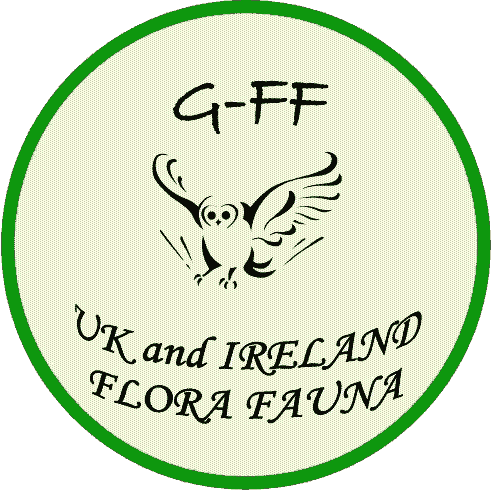
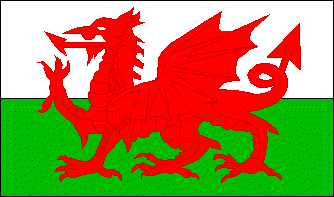
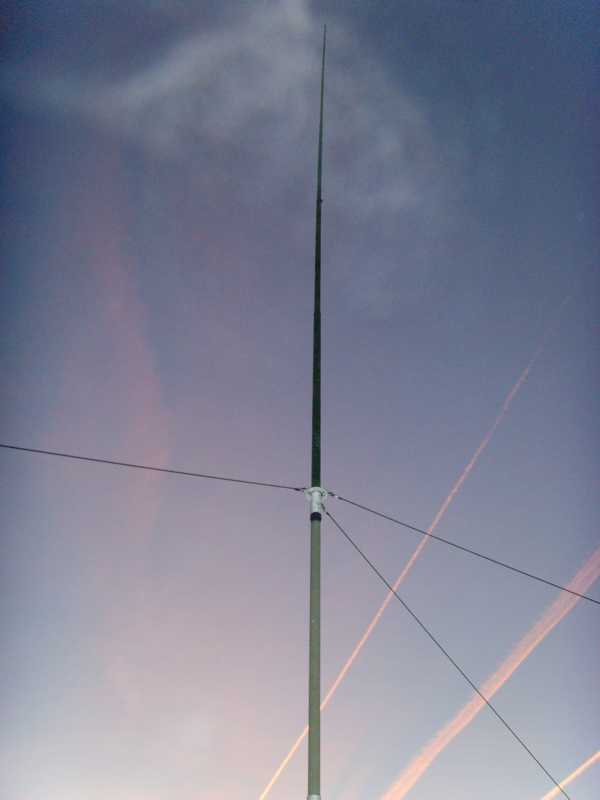 4
4 and traps has clearly been an exercise in diminishing returns.
and traps has clearly been an exercise in diminishing returns.  Teflon blended thermo- plastics, high conductivity copper-beryllium (Photo – right) and extremely reliable stepper motors has allowed the SteppIR to be a commercially feasible product. There are questions on how it will survive the test of time, extreme cold temperatures and other variables but these cannot be answered with certainty, it would be wrong to do so. Some also
Teflon blended thermo- plastics, high conductivity copper-beryllium (Photo – right) and extremely reliable stepper motors has allowed the SteppIR to be a commercially feasible product. There are questions on how it will survive the test of time, extreme cold temperatures and other variables but these cannot be answered with certainty, it would be wrong to do so. Some also  question how they will stand up to the conventional trapped beams due to how many moveable parts there are involved in the design. Again it would be wrong to second guess the designers but they are highly confident all will be good in the future years.
question how they will stand up to the conventional trapped beams due to how many moveable parts there are involved in the design. Again it would be wrong to second guess the designers but they are highly confident all will be good in the future years.

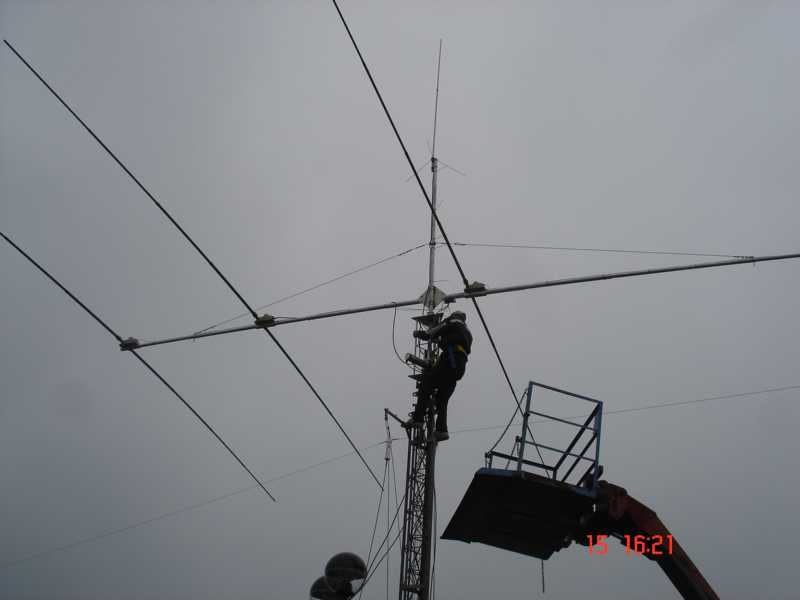

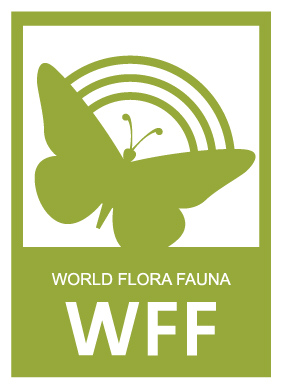
 Again, as several other sites, Bolton Ings is recently aquired and is a beatiful spot tucked away down in the Dearne Valley of South Yorkshire, Northern England.
Again, as several other sites, Bolton Ings is recently aquired and is a beatiful spot tucked away down in the Dearne Valley of South Yorkshire, Northern England.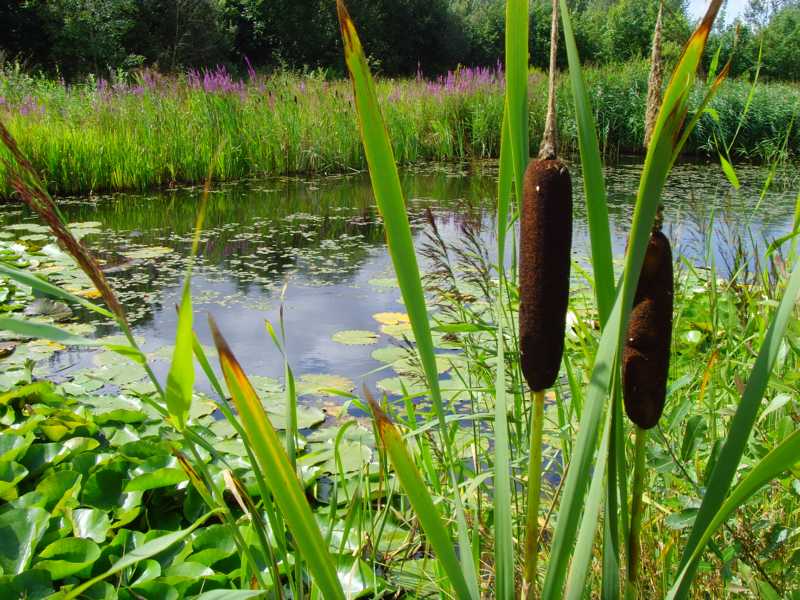 as they compete to establish territories and attract a mate. In summer, look out for young birds making their first venture into the outside world. Autumn brings large movements of migrating birds – some heading south to a warmer climate, others seeking refuge in the UK from the cold Arctic winter. In winter, look out for large flocks of birds gathering to feed, or flying at dusk to form large roosts to keep warm.
as they compete to establish territories and attract a mate. In summer, look out for young birds making their first venture into the outside world. Autumn brings large movements of migrating birds – some heading south to a warmer climate, others seeking refuge in the UK from the cold Arctic winter. In winter, look out for large flocks of birds gathering to feed, or flying at dusk to form large roosts to keep warm. spring, the sedge warbler is easy to see because it ‘pirouettes’ up into the air from the tops of the bushes, singing its scratchy song as it goes. In spring, watch the display flights of redshanks over the wetlands. Also look out for the adults walking through the water, showing off their long, red legs. The warm days of summer bring dragonflies out and about, with banded demoiselles a particular highlight. These iridescent green and black damselflies flutter over the surface of the water. The reedbed warblers will be feeding chicks and kingfishers whizz to and fro carrying fish for their young. Broods of ducklings can be seen feeding with their mothers.
spring, the sedge warbler is easy to see because it ‘pirouettes’ up into the air from the tops of the bushes, singing its scratchy song as it goes. In spring, watch the display flights of redshanks over the wetlands. Also look out for the adults walking through the water, showing off their long, red legs. The warm days of summer bring dragonflies out and about, with banded demoiselles a particular highlight. These iridescent green and black damselflies flutter over the surface of the water. The reedbed warblers will be feeding chicks and kingfishers whizz to and fro carrying fish for their young. Broods of ducklings can be seen feeding with their mothers.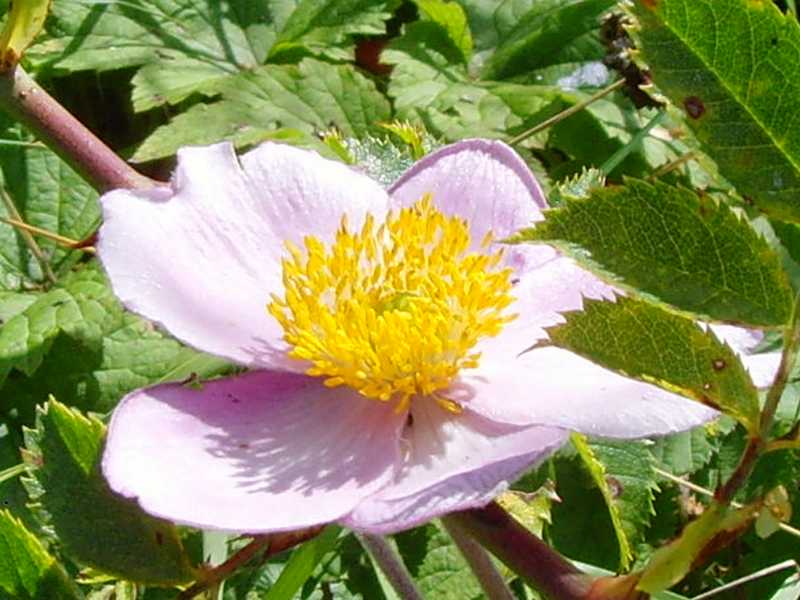 stop their ‘mobbing’ attacks until the danger has passed.
stop their ‘mobbing’ attacks until the danger has passed.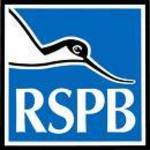
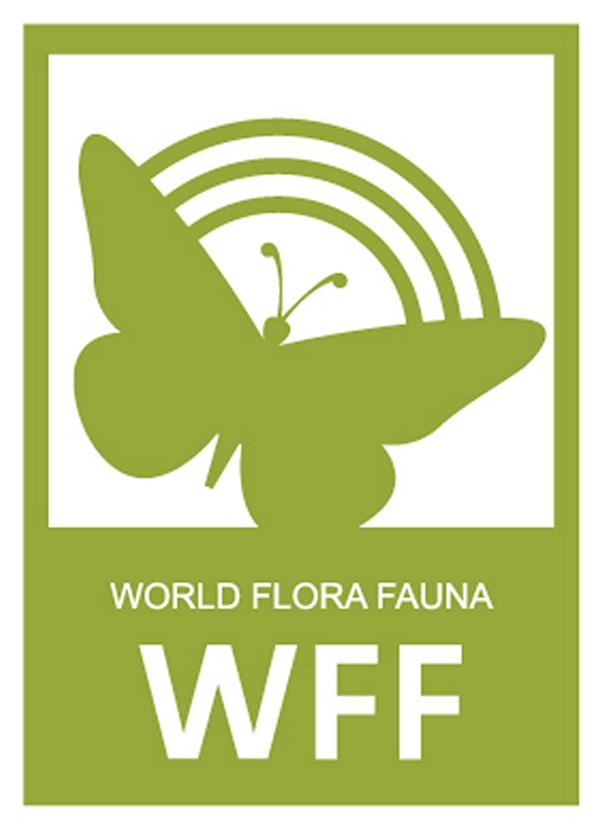
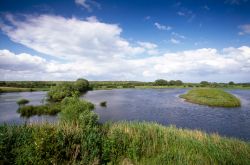 Nature Reserve for the RSPB and another great place to come and see the Wildlife whilst combining it together with the hobby of Amater Radio. The skies, fields and open water areas are teeming with birds throughout the Year.
Nature Reserve for the RSPB and another great place to come and see the Wildlife whilst combining it together with the hobby of Amater Radio. The skies, fields and open water areas are teeming with birds throughout the Year. 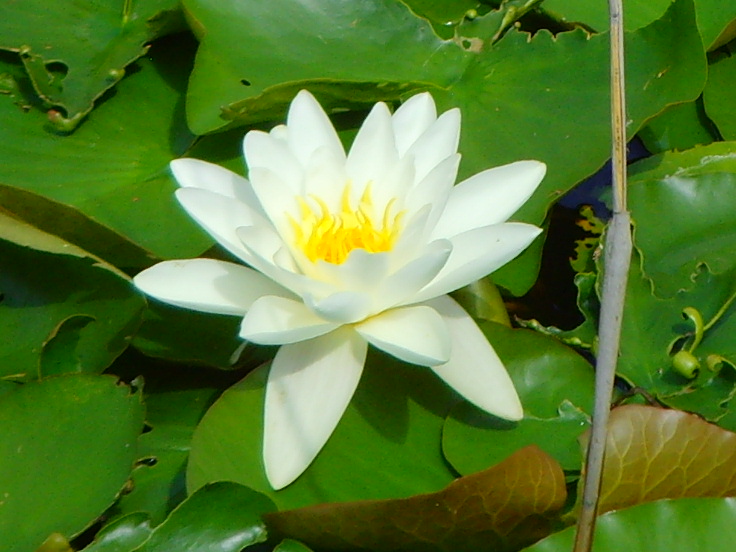 programme of events, there is something for everyone to enjoy including children on school trips and groups or individuals wanting a more one on one guided tour.
programme of events, there is something for everyone to enjoy including children on school trips and groups or individuals wanting a more one on one guided tour.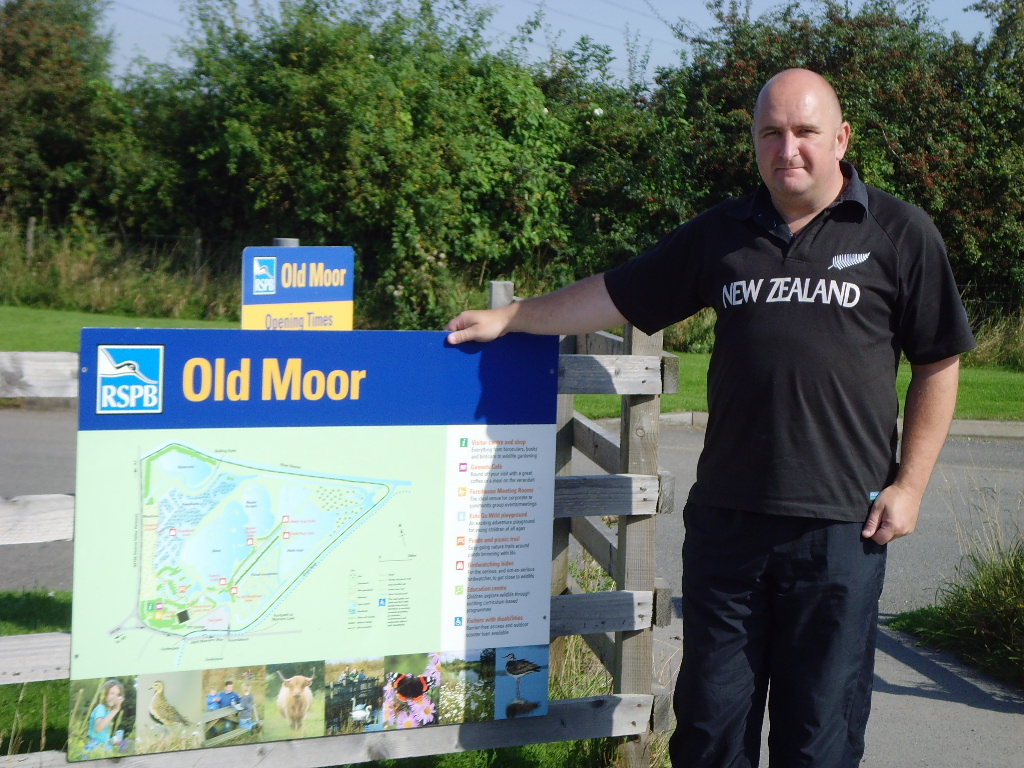 as well as the new additions to the families of the wildfoul and other Birds. dragonflies were also in abundance even if they were difficult to catch on camera! Old Moor is very important in the Winter time as it is a regular stop to over 8000 Golden Plovers. Current sightings of a Bittern on the reserve was great news too!
as well as the new additions to the families of the wildfoul and other Birds. dragonflies were also in abundance even if they were difficult to catch on camera! Old Moor is very important in the Winter time as it is a regular stop to over 8000 Golden Plovers. Current sightings of a Bittern on the reserve was great news too!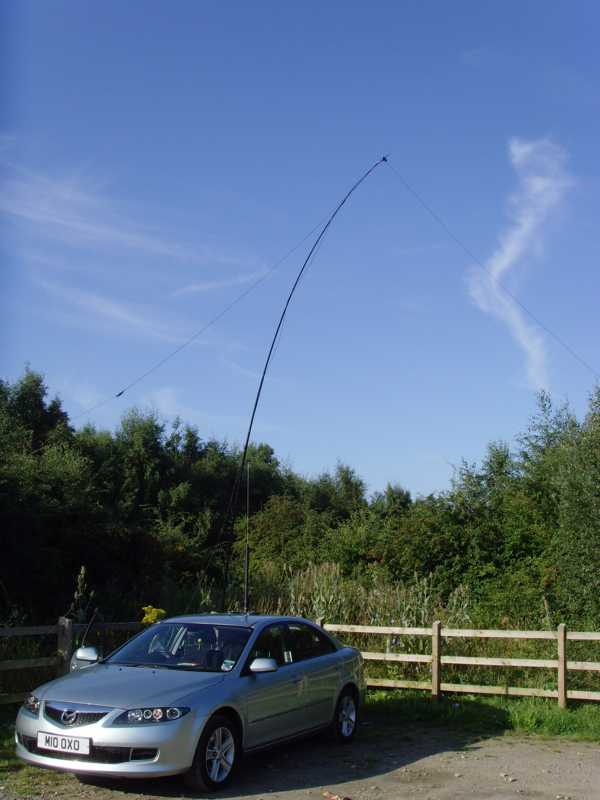 decline to an amazing 93% between the 70’s and present times and at that time there were only 4 pairs breeding on the site. Today however there are approx. 50 breeding pairs and individually over 400, another good result for Old Moor.
decline to an amazing 93% between the 70’s and present times and at that time there were only 4 pairs breeding on the site. Today however there are approx. 50 breeding pairs and individually over 400, another good result for Old Moor. volunteering on the site for some time and this has enabled the RSPB at Old Mill to begin a fruitful partnership with Mencap nearby in the city of Leeds. They have also included an ”insect hotel”, made out of salvaged bricks, pallets, and old roof tiles amongst other things!
volunteering on the site for some time and this has enabled the RSPB at Old Mill to begin a fruitful partnership with Mencap nearby in the city of Leeds. They have also included an ”insect hotel”, made out of salvaged bricks, pallets, and old roof tiles amongst other things!
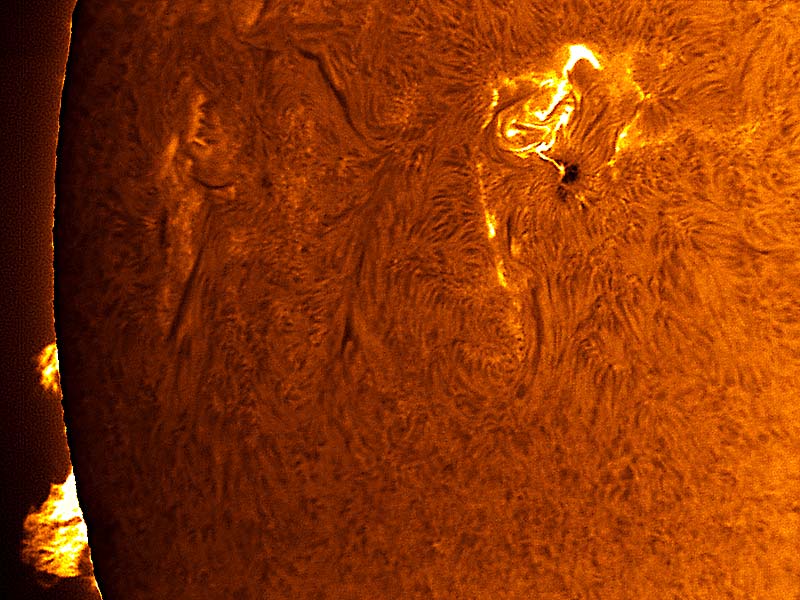 Throughout the next 90 minutes I managed to work 16 JA (Japan), 3 DU (Philippines), Luis in HI9 and several others stations in Asiatic Russia. (See log extract below).
Throughout the next 90 minutes I managed to work 16 JA (Japan), 3 DU (Philippines), Luis in HI9 and several others stations in Asiatic Russia. (See log extract below).